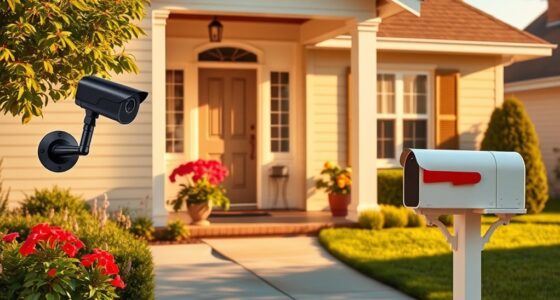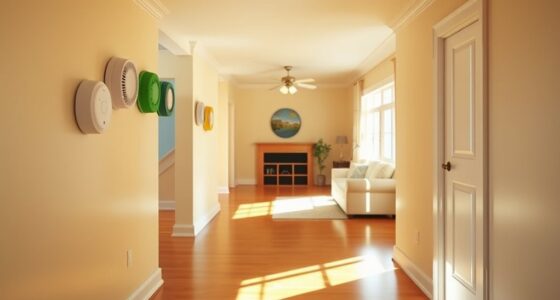Burglars look for signs of vulnerability like unsecured doors, poor lighting, and neglect that make homes easy targets. They seek visible clues showing minimal security, such as uninstalled cameras or weak locks. Timing also matters—they prefer when homeowners are away or routines are predictable. Whether opportunistic or planned, they aim for low-risk, quick gains. Knowing these signals can help you spot and reduce your home’s attractiveness to intruders if you look closer.
Key Takeaways
- Burglars assess homes quickly for vulnerabilities like unlocked doors, weak locks, and minimal security features.
- They look for signs of neglect, outdated security, or signs of occupancy that suggest easy access.
- Visible security measures such as cameras or alarms deter intruders by increasing perceived risk.
- Opportunistic burglars target homes with environmental cues like poor lighting, overgrown landscaping, or signs of neglect.
- They prefer targets with predictable routines and lack of neighborhood vigilance, making planning easier.
Common Target Choices and Why They Attract Burglars

Burglars tend to target homes and properties that are easy to access and offer high rewards with minimal risk. They often look for houses without visible alarm systems, making entry and exit simpler without drawing attention. Neighborhoods with a lack of active neighborhood watch programs also appeal to burglars, as they decrease the chance of being caught. If your home lacks security measures, it signals vulnerability and invites intrusion. A visible alarm system can act as a deterrent, alerting you and authorities quickly if someone tries to break in. Similarly, neighborhood watch programs help create a community-wide security network, making it less attractive for burglars to target your property. Incorporating protective styling benefits such as security features can further enhance your home’s defenses. Keep these factors in mind to reduce your risk of becoming a target.
The Role of Security Vulnerabilities in Target Selection

Homes lacking visible security features or easy escape routes stand out as prime targets for intruders. Burglars constantly scan for security flaws that signal ease of entry and exit. They perform quick vulnerability assessments, looking for unsecured doors, weak locks, or hidden entry points. If a home shows signs of neglect or has outdated security measures, it becomes more attractive. Intruders prefer targets where they can minimize risk and effort. They avoid homes with visible alarms, cameras, or reinforced doors, as these increase the chance of detection. Your awareness of potential vulnerabilities influences your ability to protect your property. By addressing common security flaws, you reduce your home’s appeal to burglars, making it less likely for them to see it as an easy opportunity. Furthermore, understanding creative practice can help homeowners develop innovative security solutions that effectively deter intruders.
Timing and Frequency: When Do Burglars Usually Strike?
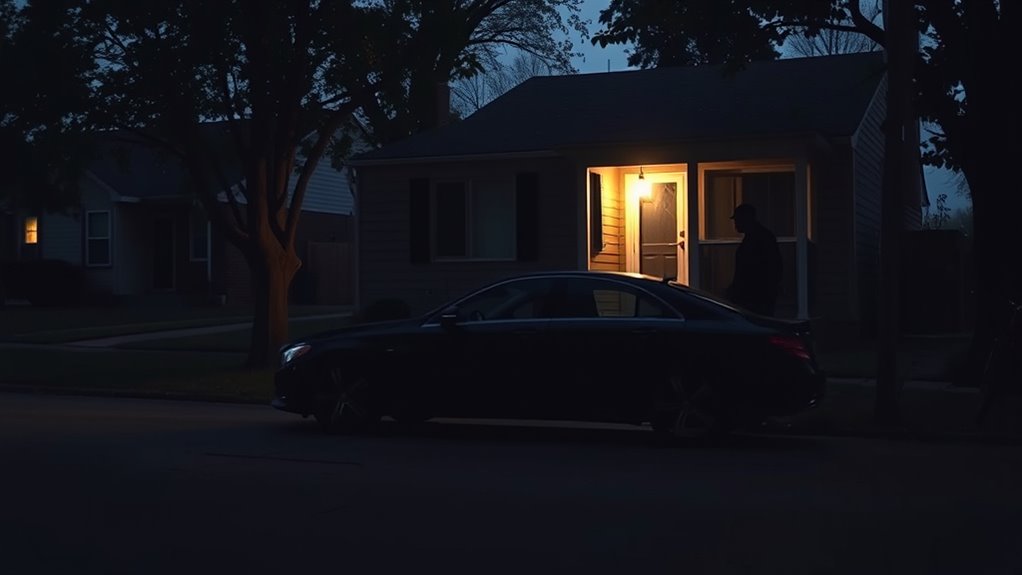
Many burglaries occur during specific times when homes are most vulnerable, often when occupants are away or distracted. Typically, burglars target late mornings, afternoons, or weekends when people are at work, school, or errands. They also prefer times when alarm systems might be less active or less effective, such as during holidays or vacations. A strong neighborhood watch can deter these criminals, as they tend to avoid areas with visible patrols and vigilant residents. Timing is essential—most burglars strike when they believe the risk of being caught is low. Additionally, home security technology plays a significant role in deterring potential intruders by increasing the perceived risk of detection. By understanding these patterns, you can better plan your security measures, like scheduling alarm system alerts or participating actively in neighborhood watch programs, to reduce the chances of becoming a target.
The Influence of Opportunistic vs. Planned Break-Ins
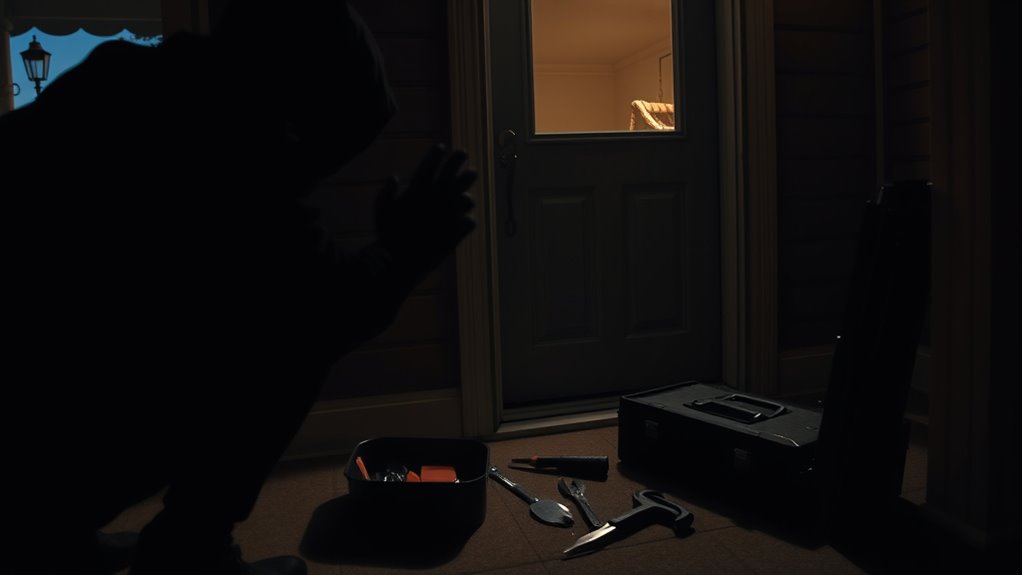
While some break-ins happen spontaneously when burglars come across an easy target, others are carefully planned in advance. Opportunistic burglars seize chances, like unlocked doors or visible valuables, especially if they notice security system vulnerabilities. They often rely on quick, unplanned decisions, making homes with minimal security more attractive. Planned burglars, however, gather information ahead of time, watching neighborhoods and noting patterns, especially if a neighborhood has an active watch program. They look for homes that seem accessible and unprotected, avoiding those with security cameras or alarms. A strong neighborhood watch can deter both types by increasing perceived risks and making burglars think twice before approaching. Understanding these dynamics helps you better protect your home from both opportunistic and planned intrusions. Additionally, maintaining a positive energy and visualizing safety can influence the likelihood of a home being targeted, as suggested by Law of Attraction principles.
Environmental Cues That Signal a Vacant or Accessible Home

Environmental cues can strongly influence a burglar’s perception of whether a property is vacant or easily accessible. For example, inadequate security lighting creates shadows and dark spots, making it easier for them to approach unnoticed. Conversely, well-lit areas signal that the home is monitored or occupied. Unlocked doors or windows are clear indicators that entry is simple and risk is low, encouraging a break-in. Overgrown landscaping or accumulated mail and packages also suggest no one’s home. These cues collectively send signals about the home’s occupancy status. Burglar’s often look for environments that seem unprotected or neglected, as these reduce the likelihood of confrontation or detection. Being aware of these cues can help you better secure your property against opportunistic intruders. Additionally, neglecting regular maintenance may lead to overlooked vulnerabilities that burglars recognize as signs of an easy target security vulnerabilities.
How Visual Cues and Signs Influence Burglars’ Decisions

Visual cues and signs play a crucial role in shaping a burglar’s decision to target a home. They send subtle messages about security, occupancy, or vulnerability, which can deter or attract a burglar. For example, visible security system signage can signal that a home is protected, reducing the likelihood of a break-in. Conversely, signs like “Beware of Dog” or “No Trespassing” can influence a burglar’s perception of risk. Use the table below to understand some common signage influence factors:
| Signage Type | Effect on Burglars |
|---|---|
| Security system signs | Deters or causes hesitation |
| “Beware of Dog” signs | Signaling potential danger |
| “No Trespassing” signs | Communicates restricted access |
| Visible lights | Increases perceived risk of detection |
| Camera warnings | Suggests surveillance, discouraging entry |
Understanding these visual cues helps you protect your home effectively. Additionally, the use of artistic and customized planters can enhance home aesthetics and potentially signal occupancy, subtly discouraging intruders.
Psychological Factors Driving the Desire for Quick, Low-Risk Gains
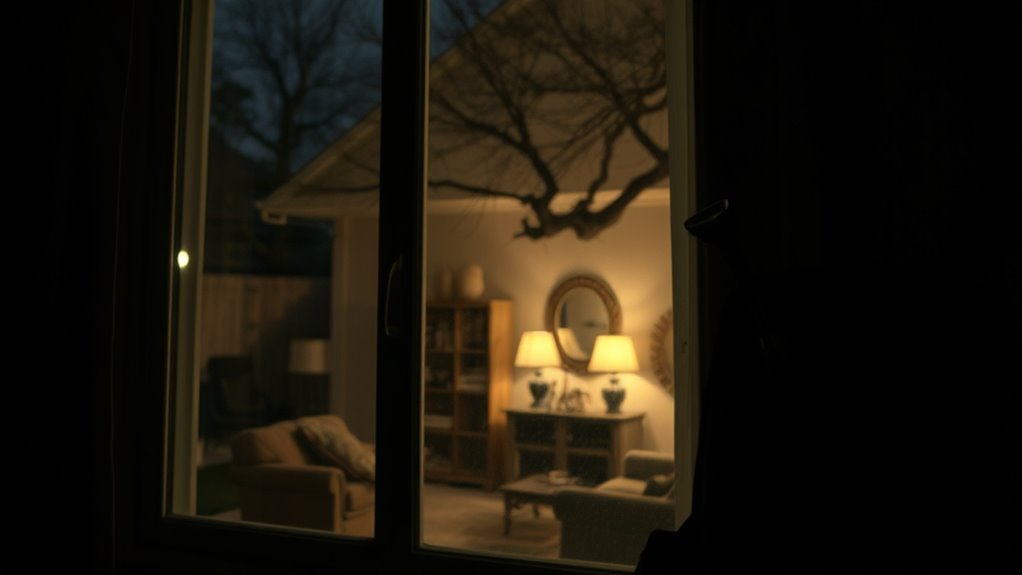
The desire for quick, low-risk gains often drives burglars to target opportunities that promise immediate rewards with minimal danger. Motivational factors like financial pressure or impulsivity push them toward easy wins rather than long-term planning. Risk assessment plays a vital role; burglars tend to prefer targets they perceive as less likely to lead to confrontation or capture. They evaluate escape routes, security measures, and the likelihood of detection before acting. This focus on minimizing risk increases the appeal of homes with visible signs of neglect or those with less sophisticated security. Additionally, the presence of visible security measures can deter some burglars, but others may see these as opportunities to exploit vulnerabilities. Ultimately, their goal is to maximize payoff while reducing the chance of getting caught, which explains their preference for quick, low-risk opportunities over complex or high-risk burglaries.
The Impact of Routine and Predictability on Burglary Patterns
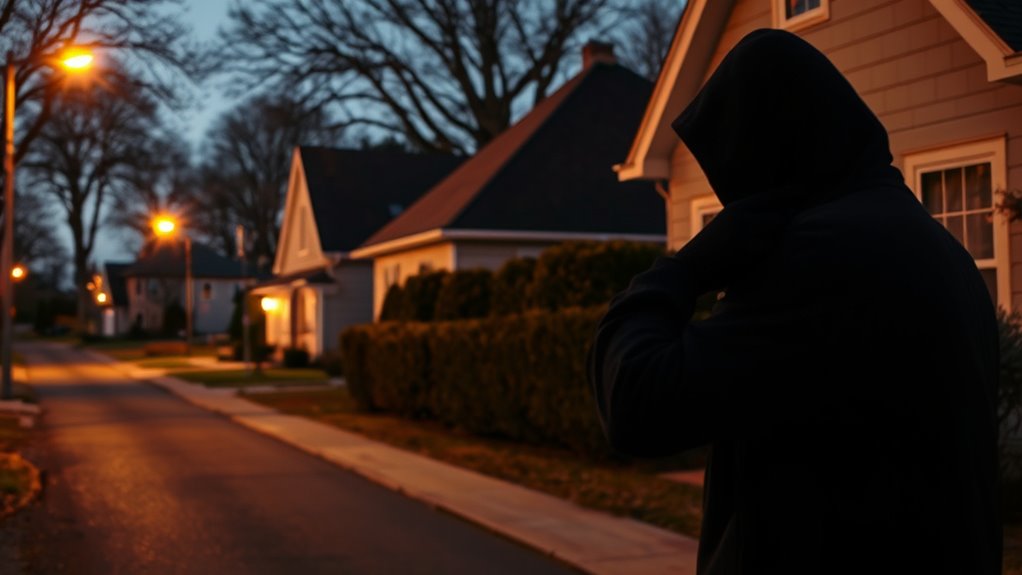
Routine and predictability heavily influence burglar behavior, as criminals often exploit patterns in victims’ lifestyles. If you leave your home at the same time daily or have predictable routines, burglars can time their visits accordingly. Effective security camera placement can deter break-ins and provide valuable evidence if a burglary occurs, especially when positioned to cover common entry points. Additionally, participating in a neighborhood watch creates a community-driven effort to monitor suspicious activity, disrupting burglars’ plans. When routines are unpredictable and your home’s security measures are visible, burglars are less likely to target you. By varying your schedule and maintaining an active neighborhood watch, you make it harder for burglars to identify predictable patterns, reducing the likelihood of a break-in. Implementing security measures like eye patches can also serve as a visual deterrent and help protect your home, especially if they are placed in visible areas to make potential intruders aware of additional security precautions.
Frequently Asked Questions
How Do Burglars Assess the Risk of Getting Caught?
You probably wonder how burglars gauge their chances of getting caught. They actively look for security cameras and alarm systems, which increase their risk of detection. If a property has visible cameras or signs of alarm systems, they tend to avoid it, preferring easier targets. They assess these risks quickly, often choosing homes that seem less monitored to minimize the chance of encountering security measures, ensuring their plans stay undetected.
What Psychological Traits Are Common Among Burglars?
You might wonder about the psychological traits common among burglars. Their motivations behind crimes often include financial gain, thrill-seeking, or desperation. They tend to have psychological profiles marked by impulsivity, risk-taking, and sometimes a lack of empathy. Understanding these traits can help you recognize warning signs and improve security, as burglars often target homes where they perceive lesser psychological resilience or vulnerability.
How Does Neighborhood Reputation Influence Burglary Decisions?
Oh, the charm of a neighborhood with a stellar reputation—nothing screams “easy target” like a community where trust is a myth. Burglars see a place with a shaky community reputation and low neighborhood trust as an open invitation, knowing residents are less likely to notice or intervene. So, if you’re counting on your reputation to deter crime, remember: reputation can be a fragile shield.
Do Burglars Prefer Targeting Specific Types of Homes?
You wonder if burglars prefer certain homes. They typically target homes with higher vulnerability, such as those with weak locks, poor lighting, or visible valuables. These factors influence their target selection, as they look for easy entry points and minimal risk of getting caught. By understanding what makes a home vulnerable, you can better protect your property and reduce the chances of becoming a target.
How Do Burglars Plan Escape Routes After Breaking In?
Burglars plan escape routes by carefully observing your home’s security camera placement and identifying the easiest exits. They often choose routes that are less monitored, like side doors or back alleys, to avoid detection. Before breaking in, they might scout for nearby cover or escape routes, ensuring they can leave quickly if caught. Effective security camera placement helps deter them, making it harder to plan a smooth escape.
Conclusion
By understanding what catches a burglar’s eye, you can gently steer your home away from their preferred choices. Small changes, like hiding valuables and signaling activity, subtly encourage them to look elsewhere. Remember, a welcoming yet secure environment makes your home less inviting for unwanted visitors. By being mindful of these cues, you create a peaceful oasis where your peace of mind can flourish without worry. Your thoughtful precautions make all the difference.



